In this article, we will share MP Board Class 11th Chemistry Solutions Chapter 12 Organic Chemistry: Some Basic Principles and Techniques Pdf, These solutions are solved by subject experts from the latest edition books.
MP Board Class 11th Chemistry Solutions Chapter 12 Organic Chemistry: Some Basic Principles and Techniques
MP Board Class 11 Chemistry Organic Chemistry: Some Basic Principles and Techniques Textbook Questions and Answers
Question 1.
What are hybridisation states of each carbon atom in the following compounds? CH2 = C = O, CH3CH = CH2, (CH3)2CO, CH2 = CHCN, C6H6.
Solution.
The hybridisation of each carbon is written as superscript on the carbon atom in the molecule.

Question 2.
Indicate the o-and K-bonds in the following molecules : C6H6, C6H12, CH2C12, CH2 = C = CH2, CH3NO2, HCONHCH3
Solution.
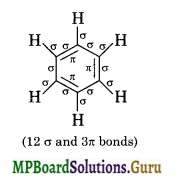
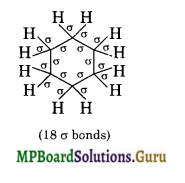
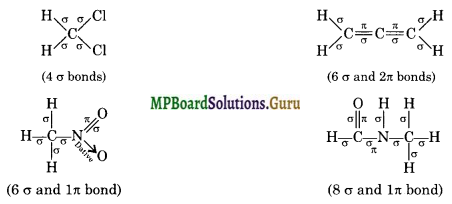
Question 3.
Write bond-line formulas for: Isopropyl alcohol 2, 3-dimethyl butanal, heptane-4-one.
Solution.
The bond line formulas of the above molecules are:

Question 4.
Give the IUPAC names of the following compounds:
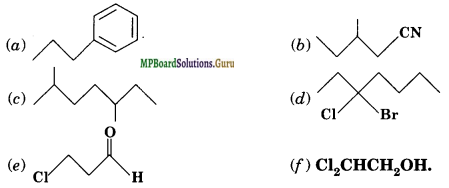
Solution.
(a) Propylbenzene
(b) 3-Methylpentanenitrile
(c) 2, 5-Dimethylheptane
(d) 3-Bromo-3-chloroheptane
(e) 3-Chloropropanal
(f) 2, 2-Dichloroethanol.
Question 5.
Which of the following represents the correct IUPAC name for the compounds concerned:
(a) 2,2-Dimethylpentane or 2-Dimethylpentane
(b) 2,4, 7-Trimethyloctane or 2,5,7-Trimethyloctane
(c) 2-chloro-4-methyl pentane or 4-chloro-2-methyl pentane
(d) But-3-yn-l-ol or But-4-ol-l-yne.
Solution.
(a) 2, 2-Dimethylpentane
(b) 2, 4, 7-Trimethyloctane. For two alkyl groups on the same carbon its locant is repeated twice, 2, 4, 7-locant set is lower than 2, 5, 7. (c) 2-Chloro-4-methyl pentane. Alphabetical order of substituents,
(d) But-3-yn-l-ol. Lower locant for the principal functional group, i.e., alcohol.
![]()
Question 6.
Draw formulas for the first five members of each homologous series beginning with the following compounds,
(a) H-COOH
(b) CH3COCH3
(c) H-CH = CH2.
Solution.
(a) HCOOH, CH3COOH, CH3CH2COOH, CH3CH2CH2COOHCH3-(CH2)3 – COOH
(b) CH3COCH3, CH3CH2COCH3, CH3CH2CH2COCH3,CH3CH2CH2CH2COCH3 CH3(CH2)4 COCH3
(c) CH2 = CH2, CH3CH = CH2, CH3CH2CH = CH2, CH3CH2CH2CH = CH2 CH3(CH2)3 CH = CH2
Question 7.
Give condensed and bond line structural formulas and identify the functional group(s) present, if any, for :
(a) 2, 2, 4-Trimethylpentane
(b) 2-Hydroxy-l, 2, 3-propane tri-carboxylic acid
(c) Hexanedial.
Solution.
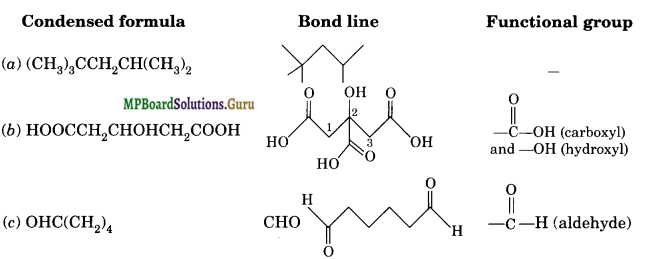
Question 8.
Identify the functional groups in the following compounds: CHO
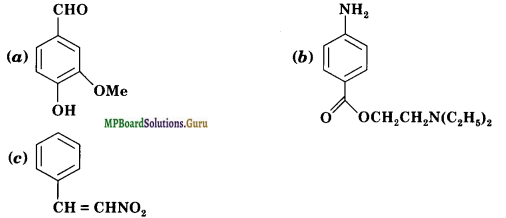
Solution.
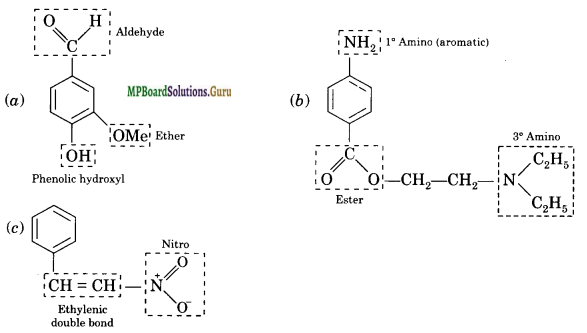
Question 9.
Which is expected to be more stable, O2NCH2CH2O– or CH3CH2O– and why?
Solution.
![]() is more stable than
is more stable than ![]() because NO2 group has -I-effect and hence it tends to disperse the -ve charge on the O-atom. In contrast, CH3CH2 exerts + I-effect. It, therefore, tends to intensify the -ve charge and hence destabilizes it.
because NO2 group has -I-effect and hence it tends to disperse the -ve charge on the O-atom. In contrast, CH3CH2 exerts + I-effect. It, therefore, tends to intensify the -ve charge and hence destabilizes it.
Question 10.
Explain why alkyl groups act as electron donors when attached to a π-system.
Solution.
Due to hyperconjugation, alkyl groups act as electron donors when attached to a 7t-system.
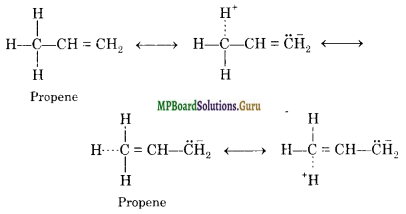
It should be noted that the H atom shown by dotted line is firmly attached.
Question 11.
Draw the resonance structures for the following compounds. Show the electron shift using curved-arrow notation.
(a) C6H5OH
(b) C6H5NO2
(c) CH3CH = CHCHO
(d) C6H5-CHO
![]()
![]()
Solution.
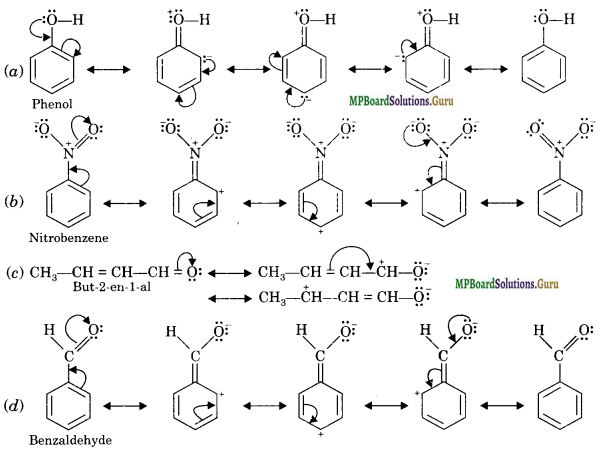
Question 12.
What are electrophiles and nucleophiles? Explain with examples.
Solution.
Nucleophiles: The neutral or negatively charged species which are capable of acting as donar electron pair (Lewis base)
(a) Neutral nucleophiles: ![]()
(b) Charged nucleophiles: :![]()
Electrophiles: The neutral or positively charged species with deficiency of electrons and capable of accepting a pair of electrons (Lewis acid)
(a) Neutral electrophiles: BF3,Alcl3,SO3,FeCl3,SiCl4,CH2,NOCL
(b) Charged electrophiles: 
Question 13.
Identify the reagents shown in the following equations as nucleophiles or electrophiles
(а) CH3COOH + HO– → CH3COO– + H2O
(b) CH3COCH3 + CN → (CH3)2C(CN)(OH)
(c) C6H6 + CH3C+O → C6H5COCH3
Solution.

![]()
Question 14.
Classify the following reactions as one of the reaction types studied:
(а) CH3CH2Br + HS– → CH3CH2SH + Br–
(b) (CH3)2C = CH2 + HCl → (CH3)2 CCl-CH3
(c) CH3CH2Br + HO– → CH2 = CH2 + H2O + Br–
(d) (CH3)3C-CH2OH + HBr → (CH3)2CBrCH2CH2 + H2O
Solution.
(a) Nucleophilic substitution
(b) Electrophilic addition
(c) Bimolecular elimination or elimination
(d) Nucleophilic substitution with rearrangement.
Question 15.
What is the relationship between the members of following pairs of structures? Are they structural or geometrical isomers or resonance contributors?

Solution.
(a) Structural isomers (actually position isomers as well as metamers)
(b) geometrical isomers
(c) resonance contributors because they differ in the position of electrons but not atoms.
Question 16.
For the following bond cleavages, use curved-arrows to show the electron flow and classify each as homolysis or heterolysis. Identify reactive intermediate produced as free radical, carbocation and carbanion.

Solution:
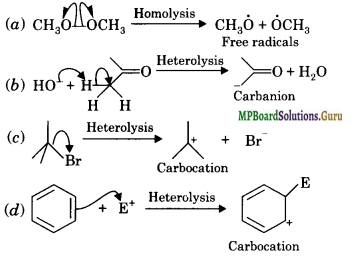
Question 17.
Explain the terms inductive and electromeric effects. Which electron carboxylic acids?
(a) Cl3CCOOH > Cl2CHCOOH > ClCH2COOH
(b) CH3CH2COOH > (CH3)2CHCOOH > (CH3)3CCOOH
Solution.
The definitions of inductive and electromeric effects is given in section (a) HCOOH, CH3COOH, CH3CH2COOH, CH3CH2CH2COOHCH3-(CH2)3 – COOH The given order of acidic character is explanable on the basis of-I-effect as shown below:

More is the number of halogen atoms greater is the – I-effect and hence more polar is the O-H bond i.e., is more. As the number of halogen atoms decreases the polarity of O-H bond decreases and hence the acidic character.
(b) The given order of acidic character is explanable on the basis of + I-effect as shown below:

As the number of alkyl groups increases, the + I-effect increases and the acid strength decreases accordingly.
Question 18.
Give a brief description of the principles of the following techniques taking an example in each case:
(a) Crystallisation
(b) Distillation
(c) Chromatography.
Solution.
For details see section

Question 19.
Describe the method, which can be used to separate two compounds with different solubilities in a solvent S.
Solution.
Two compounds with different solubilities in a solvent S can be separated by fractional crystallisation. When a hot saturated solution of these two compounds is allowed to cool, the less soluble compound crystallises out first while the more soluble remains in the solution. The crystals are separated from the mother liquor and the mother liquor is again concentrated and the hot solution again allowed to cool when the crystals of the second (i.e., more soluble) compound are obtained. These are again filtered and dried.
Question 20.
What is the difference between distillation, distillation under reduced pressure and steam distillation?
Solution.
Distillation involves conversion of a liquid into vapours followed by condensation of the vapours thus produced by cooling to get the pure liquid while the non-volatile impurities remain in the flask. This method is commonly used for those liquids which are sufficiently stable at their boiling points and contain non-volatile impurities.
Distillation under reduced pressure also involves conversion of a liquid into vapours by heating followed by condensation of the vapours thus produced by cooling but the pressure acting on the system is not atmospheric but is reduced by using a vacuum pump. Since the boiling point of a liquid decreases as the pressure acting on it is reduced, therefore, this method is used to purity such liquids which have high boiling liquids or liquids which decompose at or below their boiling points.
Steam distillation is comparable to distillation under reduced pressure (vacuum distillation) even though there is no reduction in the total pressure acting on the solution. Here, the mixture of organic liquid and water boils at a temperature when the sum of the vapour pressures of the organic liquid (px) and that of water (p2) becomes equal to the atmospheric pressure (p), i.e., p =p1+ p2.
Since the vapour pressure of water around its boiling point is quite high and that of the liquid is quite low, therefore, the organic liquid will boil at a temperature much lower than its normal boiling point and hence its decomposition is avoided. Steam distillation is used to purify such liquids which are volatile in steam, insoluble in water, possess a vapour pressure of about 10-5 mm of Hg and contain non-volatile impurities.
![]()
Question 21.
Discuss the Chemistry of Lassaigne’s test.
Solution.
For details see section

Question 22.
Differentiate between the principle of estimation of nitrogen in an organic compound by (i) Dumas method (ii) Kjeldahl’s method.
Solution.
(i) In Duma’s method, a known mass of the organic compound is heated with excess of CuO in an atmosphere of CO2, when nitrogen of the organic compound is converted into N2 gas. The dinitrogen gas is collected over water. The volume of N2 thus obtained is converted into STP and the percentage of nitrogen is determined by applying the equation,
Percentage of N = \(\frac{28 \times \text { Vol. of } \mathrm{N}_{2} \text { at STP } \times 100}{22400 \times \text { Mass of the substance taken }}\)
(ii) In Kjeldahl’s method, a known mass of the organic substance is digested (heated) with cone. H2SO4 in presence of K2SO4 and little CuSO4 or Hg (catalyst) in a long necked flask called Kjeldahl’s flask when nitrogen present in the organic compound is quantitatively converted into (NH4)2SO4. Ammonium sulphate thus obtained is boiled with excess of NaOH solution to liberate NH3 gas which is absorbed in a known excess of a standard acid such as H2SO4 or HCl.
The volume of acid unused is found by titration against a standard alkali solution. From the volume of the acid used, the percentage of nitrogen is determined by applying the equation,

Question 23.
Discuss the principle of estimation of halogens, sulphur and phosphorus present in an organic compound.
Solution.
For details see section
![]() is more stable than
is more stable than ![]() because NO2 group has -I-effect and hence it tends to disperse the -ve charge on the O-atom. In contrast, CH3CH2 exerts + I-effect. It, therefore, tends to intensify the -ve charge and hence destabilizes it.
because NO2 group has -I-effect and hence it tends to disperse the -ve charge on the O-atom. In contrast, CH3CH2 exerts + I-effect. It, therefore, tends to intensify the -ve charge and hence destabilizes it.
Question 24.
Explain the principle of paper chromatography.
Solution.
Refer to partition chromatography given in section

Question 25.
Why is nitric acid added to sodium extract before adding silver nitrate for testing halogens?
Solution.
Sodium extract is boiled with nitric acid to decompose NaCN and Na2S if present,
NaCN + HNO3 → NaNO3 + HCN ↑
Na2S + 2HNO3 →2NaNO3 + H2S ↑
If the sodium extract is not boiled with nitric acid then NaCN and Na2S formed will react with AgNO3 and hence will interfere with the test as shown below:
NaCN + AgNO3 → AgCN + NaNO3Silver cyanide (White ppt.)
Na2S + 2AgNO3 →Ag2S + 2NaNO3 Silver sulphide (Black ppt.)
![]()
Question 26.
Explain the reason for the fusion of an organic compound with metallic sodium for testing nitrogen, sulphur and phosphorus.
Solution.
The organic compound is fused with sodium metal to convert these elements (which are present in the covalent form) to ionic form. For example, sulphur is changed to Na2S, nitrogen to NaCN and phosphorus to Na3PO4. The presence of sulphide ions, cyanide ions and phosphate ions can thus be confirmed by using suitable reagents.
Question 27.
Name a suitable technique of separation of the components from a mixture of calcium sulphate and camphor.
Solution.
A mixture of CaSO4 and camphor can be separated by the following two methods:
(i) Camphor is sublimable but CaSO4 is not, therefore, sublimation of the mixture gives camphor on the sides of funnel while CaSO4 is left in the china dish.
(ii) Camphor is soluble in organic solvents like CHCl3, CCl4 etc., while CaSO4 is not. Therefore, when the mixture is shaken with the solvent, camphor goes into solution while CaSO4 remains as residue. It is filtered and evaporation of solvent gives camphor.
Question 28.
Explain, why an organic liquid vapourises at a temperature below its boiling point in its steam distillation?
Solution.
In steam distillation, the mixture consists of the organic liquid and water boils at a temperature when the sum of the vapour pressure of the liquid (p1) and that of water (p2) becomes equal to the atmospheric pressure (p), i.e., p = p1+ p2.
Since the vapour pressure of water around the boiling point of the mixture is quite high and that of liquid is quite low (10-15 mm), therefore, the organic liquid distils at a pressure much lower than the atmospheric pressure. In other words, the organic liquid vapourises at a temperature much lower than its normal boiling point.
Question 29.
Will CCl4 give white precipitate of AgCl on heating it with silver nitrate? Give reason for your answer.
Solution.
When CCl4 is heated with AgNO3 solution, white ppt. of AgCl will not be formed. The reason being that CCl4 is a covalent compound, therefore, it does not ionize to give Cl– ions needed for the formation of ppt. of AgCl.
Question 30.
Why is a solution of potassium hydroxide used to absorb carbon dioxide evolved during the estimation of carbon present in an organic compound?
Solution.
CO2 is acidic in nature, therefore, it reacts with the strong base KOH to form K2CO3.
2KOH + CO2 → K2CO3 + H2O
The increase in the mass of U-tube containing KOH then gives the mass of CO2 produced and from its mass, the percentage of carbon in the organic compound can be estimated by using the equation,
Percentage ot C = \(\frac{12 \times \text { Mass of } \mathrm{CO}_{2} \text { formed } \times 100}{44 \times \text { Mass of substance taken }}\)
Question 31.
Why is it necessary to use acetic acid and not sulphuric acid for acidification of sodium extract for testing sulphur by lead acetate test?
Solution.
For testing sulphur, the sodium extract is acidified with acetic acid because lead acetate is soluble and does not interfere with the test. If H2SO4 were used, lead acetate itself with react with H2SO4 to form white ppt. of lead sulphate which will interfere with the test.

Question 32.
An organic compound contains 69% carbon and 4.8% hydrogen, the remainder being oxygen. Calculate the masses of carbon dioxide and water produced when 0.20 g of this substance is subjected to complete combustion.
Solution.
We know that,
Percentage of C = \(\frac{12 \times \text { Mass of } \mathrm{CO}_{2} \text { formed } \times 100}{44 \times \text { Mass of substance taken }}\)
Substituting the values of % of C and mass of the substance taken, we have,
69 = \(\frac{12 \times \text { mass of } \mathrm{CO}_{2} \text { formed }}{44 \times 0.2 \mathrm{~g}} \times 100\)
or Mass of H2O formed = \(\frac{69 \times 44 \times 0.2}{12 \times 100}\) = 0.506 g
Similarly, Percentage of H = \(\frac{2 \times \text { Mass of } \mathrm{H}_{2} \mathrm{O} \text { formed }}{18 \times \text { Mass of substance taken }}\) × 100
Substituting the values of % of H and mass of the substance taken, we have,
4.8 = \(\frac{2 \times \text { Mass of } \mathrm{H}_{2} \mathrm{O} \text { formed }}{18 \times 0.2}\) × 100
or Mass of H2O formed = \(\frac{4.8 \times 18 \times 0.2}{2 \times 100}\) = 0.0864 g.
Question 33.
A sample of 0.50 g of an organic compound was treated according to Kjeldahl’s method. The ammonia evolved was absorbed in 50 ml of 0.5 M H2SO4. The residual acid required 60 mL of 0.5 M solution of NaOH for neutralisation. Find the percentage composition of nitrogen in the compound.
Solution.
Step 1. To determine the volume of H2SO4 used.
Volume of acid taken = 50 mL of 0.5 M H2SO4 = 25 mL of 1 M H2SO4 Volume of alkali used for neutralization of excess acid
= 60 mL of 0.5 M NaOH
= 30 mL of 1 M NaOH
Now 1 mole of H2SO4 neutralizes 2 moles of NaOH
(i.e., H2SO4 + 2NaOH → Na2SO4 + 2H2O)
∴ 30 mL of 1 M NaOH = 15 mL of 1 M H2SO4 Volume of acid used by ammonia
= 25 – 15 = 10 mL
Step 2. To determine percentage of nitrogen.
Again 1 mole of H2SO4 neutralizes 2 moles of NH3 10 mL of 1 M H2SO4 = 20 mL of 1 M NH3
But 1000 mL of 1 M NH3 contain nitrogen = 14 g
∴ 20 mL of 1 M NH3 will contain nitrogen = \(\frac{14}{1000} \times 20\)g
But this much amount of nitrogen is present in 0.5 g of the organic compound.
∴ Percentage of nitrogen =\(\frac{14}{1000} \times \frac{20}{0.5}\) × 100 = 56.0.
Alternatively, percentage of N can be determined by applying the following equation,

Substituting the values of all the items in the above equation, we have
percentage of N = \(\frac{1.4 \times 1 \times 2 \times 10}{0.5}\)
= 56.0.
![]()
Question 34.
0.3780 g of an organic chloro compound gave 0.5740 g of silver chloride in Carius estimation. Calculate the percentage of chlorine present in the compound.
Solution.
Here, the mass of substance taken = 0.3780 g
Mass of AgCl formed = 0.5740 g
Now 1 mole of AgCl = 1 g atom of Cl or (108 + 35.5) = 143.5 g of AgCl = 35.5 g of Cl
Applying the relation,
percentage of chlorine = \(\frac{35.5 \times \text { Mass of AgCl formed }}{143.5 \times \text { Mass of substance taken }} \times 100\)
= \(\frac{35.5 \times 0.5740 \times 100}{143.5 \times 0.3780}\)
= 37.566 g.
Question 35.
In the estimation of sulphur by Carius method, 0.468 g of an organic sulphur compound afforded 0.668 g of barium sulphate. Find the percentage of sulphur in the given compound.
Solution.
Here, the mass of the substance taken = 0.468 g.
Mass of BaS04 formed = 0.668 g Now 1 mole of BaS04 = 1 g atom of S or (137 + 32 + 4 × 16) = 233 g of BaSO4 = 32 g of S
Applying the relation,
Percentage ot Sulpher = \(\frac{32 \times \text { Mass of } \mathrm{BaSO}_{4} \text { formed } \times 100}{233 \times \text { Mass of substance taken }}\)
= \(\frac{32 \times 0.668}{233 \times 0.468} \times 100\)
= 19.60.
Question 36.
In the organic compound CH2 = CH—CH2—CH2—C = CH, the C2—C3 bond is formed by the interaction of a pair of hybridised orbitals:
(a) sp – sp2
(b) sp – sp3
(c) sp2 – sp3
(d) sp3 = sp3
Solution.
When both double and triple bonds are present, double bond is given preference while numbering the carbon chain. Thus,

∴ C2-C3 bond is formed by overlap of sp2 – sp3 orbitals.
Thus, option (c) is correct.
![]()
Question 37.
In the Lassaigne’s test for nitrogen in an organic compound, the Prussian blue colour is obtained due to the formation of:
(a) Na4[Fe(CN)6]
(b) Fe4[Fe(CN)6]3
(c) Fe2[Fe(CN)6]
(d) Fe3[Fe(CN)6]4
Solution.
The Prussian blue colour is due to the formation Fe4[Fe(CN)6l3. Thus, option (b) is correct.
Question 38.
Which of the following carbocation is most stable?
![]()
![]()
(d) CH3CHCH2CH3
Solution.
The order of stability of carbocation is :3° > 2° > 1°

Thus, option (b) is correct.
Question 39.
The best and latest technique for isolation, purification and separation of organic compounds is:
(a) Crystallisation
(b) Distillation
(c) Sublimation
(d) Chromatography
Solution.
Chromatography. Thus, option (d) is correct.
Question 40.
The following reaction is classified as:
CH3CH2I + KOH (aq) → CH3CH2OH + KI
(a) Electrophilic substitution
(b) Nucleophilic substitution
(c) Elimination
(d) Addition.
Solution.
This is an example of nucleophilic substitution reaction since the nucleophile I- is replaced by the nucleophile OH- ion. Thus, option (b) is correct.
MP Board Class 11 Chemistry Organic Chemistry: Some Basic Principles and Techniques Important Questions and Answers
Question 1.
Write the full form of TLC and IUPAC.
Answer:
Thin Layer Chromatography and International Union of Pure and Applied Chemistry.
Question 2.
Give IUPAC name of (i) acetonitrile (ii) acrylic acid
Answer:
CH3CN (ethane nitrite) CH2</sub< = CH—COOH (Prop-2-enoic acid)
Question 3.
Classify the following species into electrophiles and nucleophiles
SO3, BF3, H2O, OH
Answer:
Electrophiles: SO3, BF3; Nucleophiles : H2O, O-H
Question 4.
Write the IUPAC names of the following compounds :
(i) (CH3)2C = CH2
(ii) (CH3)2CH-CH2-CH2Cl
Answer:
(i) 2-Methylpropene
(ii) 1-Chloro-3-methyl butane.
Question 5.
Write the structural formulae :
(i) But-3-en-l-ol
(ii) 2-Aminoethanol
Answer:
(i) HOH2C-CH2-HC = CH2
(ii) H2N-CH2-CH2OH
Question 6.
Describe the method to separate two substances which have different solubilities in a solvent X?
Answer:
Fractional crystallisation.
![]()
Question 7.
Give the formula of iron (III) hexacyanoferrate (III). When it is formed during the Lassaigne’s test?
Answer:
Fe4[Fe(CN)6]3. It is formed in the Lassaigne’s test for N in the organic compound.
Question 8.
Why is an organic compound fused with sodium metal for testing nitrogen, sulphur and halogens?
Answer:
The elements react with sodium to form sodium salts which are soluble in water.
Question 9.
A mixture contains two components A and B. The solubilities of A and B in water are 10 g per 100 mL and 2 g per 100 mL respectively. How would you separate this mixture?
Answer:
Fractional crystallisation.
Question 10.
A mixture contains nitrobenzene and benzoic acid. How can this mixture be separated into its constituents by technique of extraction using appropriate chemical reagent?
Answer:
By using hot water as solvent and adopting differential extraction. Benzoic acid is soluble in hot water and gets recrystallised on cooling. Nitrobenzene is not soluble in hot water.
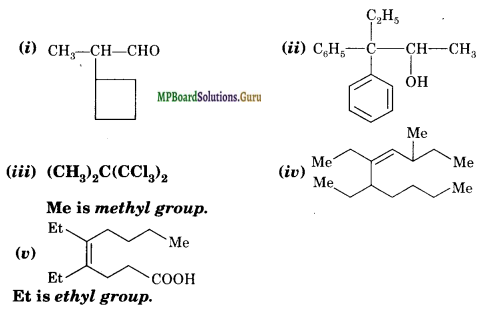
Answer:
(i) 2-Cyclobutylpropanal
(ii) 3, 3-Diphenyl-pentan-2-ol
(iii) 1, 1, 1, 3, 3, 3-Hexachloro-2, 2-dimethylpropane
(iv) 5, 6-Diethyl-3-methyldec-4-ene
(v) 5-Ethyl-4-methyl-non-4-enoic acid
![]()
Question 12.
Why is it necessary to use ethanoic acid and not sulphuric acid for acidification of sodium extract for testing sulphur by lead acetate test?
Answer:
Lead sulphate will form as precipitate which will interfere in the test.
Question 13.
Suggest a suitable technique of separating naphthalene from kerosene present in a mixture.
Answer:
Fractional distillation.